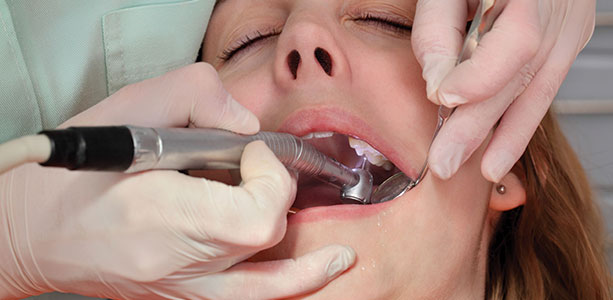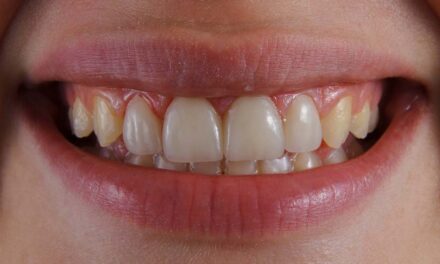My dentist consultant suggested that “drilling” is a “scary” term and we might use others that have less of a “cringe” factor. Maybe it’s “preparing the tooth, adjusting the tooth enamel, removing the decay, or smoothing the tooth surface with a diamond instrument.”
After a recent dental visit, I went to meet with a colleague. I told him I just had lunch with my dentist on the deck of a nice restaurant with a view of San Francisco bay. “Lunch with your dentist!” he said surprised, “I imagine that must have been before your treatment, not afterwards, or the food would be falling out of your mouth?” “No, after my treatment,” I replied, “in fact my dentist just did two fillings and a crown. I don’t get injections for dental work and I haven’t for about forty years, so my face wasn’t numb.”
“Wow! that’s impressive,” said the friend, “How do you manage? Why don’t you write an article about that.”
It’s true, I haven’t taken injections or other painkillers like nitrous oxide, during dental work since the 1970s and our conversation got me thinking about different ways to handle pain, and that it might be an interesting subject to explore. Well, here’s my review on this topic.
When people are asked about what causes them anxiety, going to the dentist is high on the list. Just imagining a visit to the dentist may trigger fear or even anxiety and pain. By the way, the brain doesn’t know the difference between what you imagine and what is really happening.
How do you manage the anxiety or pain of going to the dentist? Do you use affirmations? This might be as simple as saying to yourself, “I will not experience pain during my visit today. I will relax fully and let my dentist do her work.” What do you do if you start to tense up? Can you relax? Do you use music to focus your attention and block out the sound of the drill? If so, do you have a favorite playlist? I have personally used a couple acupuncture points, like “hoku” or Large Intestine 4 on the hand in the notch between the thumb and the index finger. This helped my children when they had fillings done without anesthetic.
Of course, pain is pain as it forms in the brain, and from my experience, there is a wide spectrum related to how people handle pain, from a low to high threshold. Regarding dental pain, many people are even more sensitive. Maybe it’s because most of us experienced that loud and scary drill when we were youngsters and some of the drilling really hurt. For many, however, and from my interviews with people, the fear and anxiety about potential pain is often worse than what actually happens in the dental chair—the occasional pain that can happen as part of the drilling and filling teeth, preparing crowns, and the routine dental cleanings.
NOTE: My dentist consultant suggested that “drilling” is a “scary” term and we might use others that have less of a “cringe” factor. Maybe it’s “preparing the tooth, adjusting the tooth enamel, removing the decay, or smoothing the tooth surface with a diamond instrument.”
I am speaking from my personal experience in receiving much dental work without any anesthetic injection. I’ve had multiple crowns and fillings done over the years, as well as having had all the silver-mercury amalgams removed and replaced with gold initially and later with composite fillings, which I still have. And I’ve had both my kids and some friends handle the dental experience of fillings without the “caine-numbing” shots.
NOTE: on Anesthetic Drugs: Dentists have been administering local anesthesia for many years – starting with Novocaine injections into the gums to numb the local area before drilling or doing other work on a tooth. There are newer versions of this drug, such as Lidocaine, Marcaine, or Carbocaine, and they have minimal side effects, although allergic reactions can occur, as can bruising of the gum areas or prolonged numbness of the area. There has also been some concern about the carcinogenicity of the “caine” drugs, specifically Lidocaine. Some injections contain epinephrine as well, and this can lessen bleeding at the gums, but can also agitate people and cause them more anxiety. Some dentists prefer nitrous oxide gas to help relax people and to alter their pain sensation. However, the gas is found to have dangers to the brain and nervous system, so it is used much less often these days. Of course, this article emphasizes what I support—living free from anesthetics (and pharmaceuticals in general) when possible. On the other hand, dentists have legitimate concerns about patients jumping in pain or grabbing them, and issues of oral damage from quick movements or reactive patients. Overall, it’s crucial to find the appropriate approach for each person and their chosen dentist.
Would you like to know how this non-drug dentistry can be done? Some of you will say, “No way! Why?” Just the idea and memories of drilling the teeth that we have experienced previously may make us want to go numb. So we may even request local anesthesia for teeth cleaning and simple, superficial cavities. Of course, I am also aware that all dentists and especially those who care for younger children have learned more about gentleness and many ways to lessen pain and make the dental experience much better than decades ago. Also, some dentists may have learned hypnosis while still in dental school or afterwards, and this technique can be useful for any anxious patients or very scared children, having them relax deeply and imagine for instance that they are watching their favorite TV show.
I suggest here that the common application of anesthetics isn’t needed as often as it is used. I wonder if we could save the typical mouth and face numbing primarily for the deeper cavities and drilling. Most of the tooth enamel does not have a huge amount of sensation. “It can be like getting a haircut,” says dentist, Lila Skelley, although of course, dentistry is often much more than that. She confirms that teeth don’t have a lot of sensation unless the work goes deep and connects with the dental nerves or irritates the gum tissues. So I also suggest that you talk to your dentist before any procedure and find out if the nerves or gums will be affected rather than having injections every time as a matter of course.
Why did I even think about avoiding numbing injections? What was my motivation? It wasn’t even that I didn’t like needles or shots; I liked less the numb feeling and being uncomfortable for hours after dental work. Also, I was in my new lifestyle approach of natural living, not wanting any pharmaceutical drugs put into my body unless absolutely necessary. I still practice that approach many decades later.
My exploration began back in the mid-1970s when I was studying Chinese and natural medicines. I realized that health and healing, “is all about energy!” According to Chinese Medicine, energy, called Chi, flows within us through the “meridian” channels, and when all is flowing without obstructions, we experience good health and vitality. Pain comes from an energy build-up (often with subsequent inflammation) or blockage in the flow. So, keeping everything moving became my goal. In Western science, pain is in the brain. It’s often how we perceive experiences that connects to how much pain we have.
So, what is the dentist’s drilling if not a loud and intense energy (referred to as neural-electric energy)? I thought, “Why can’t I just let that drill energy flow through me without resisting and see how that works?” So, at my next visit to Dr. Randy Rush, my local Bolinas town dentist in 1977, we drilled and filled a cavity without any anesthetic. I experienced a twinge of nerve pain and I gripped the armrests rather tightly and took a deep breath. We made it through. Of course, Randy was a little unsure and uncomfortable doing this since he didn’t want to hurt me. When I walked out of the office, however, I felt fine, even great, with no after effects, no numb lips and cheek, and no pain.
Another potential benefit of this no-drug approach involves the dentist. This is because dentists need to be more cautious with technique and the intensity of their work, and need to stay attuned to the patient and their pains, and often work more slowly and gently. The benefit to the patient is there may be less subsequent swelling and tissue pain after the treatment. I can’t remember experiencing any post-treatment pains or problems, and that’s after crowns and drilling and filling. This process may take a bit more time if the dentists adapt their speed, but remember; we are saving the time and cost of an injection, the time it takes to get numb and the extra time to recover. Of course not every dentist—and I’ve had six or seven of them work in my mouth in the past 40 years— embraces this for a variety of reasons.
So here’s how I approach injection/drug-free dentistry. To begin with, I visualize any drilling, the noise and vibration, as energy moving through the tooth and my whole body; I don’t resist and tighten. I let it go and let it flow. The next challenge or step is how to apply this same approach to any nerve stimulation and perceived “pain.” I use a similar technique—I repeat and say to myself, “This is energy passing through my nerve,” I don’t call it “pain” and I don’t resist. “It’s just a moment,” I tell myself and it passes almost as quickly as I can identify it. Crazy? I don’t think so.
How is this any different than taking a natural approach to dealing with a headache? It’s easy to just think, “I have a headache and what can I take to make it go away?” That’s a typical Western Medicine approach. I have taught and lived a more integrative and natural approach. “Why do I have this headache? Am I stressed? Dehydrated? Is my neck out of alignment? Is it intestinal toxicity from bad food or drink?” Ideally, for any condition, it’s a higher level of medicine to figure out and address the underlying cause. This doesn’t mean that we must suffer with pain; we can always use medicines to help counter problems, but my message is not as a first step. Ideally, my medical model is “Lifestyle first, Natural Therapies, next, and Drugs last.”
So, why do the dentists and most patients automatically assume that the mouth needs to be numbed for most procedures? What about just doing the various “caine” drugs for those situations where they know that it’s going to be intense? My point here is to reconsider this approach and attitude and try to handle some simpler procedures or superficial fillings first as an experiment.
My general suggestion is this: A good portion of the drilling and filling is at most, minimally painful, and momentary as well. And it’s often tolerable to go without shots and numbing and see how you feel. Work with your dentist to see if you can cooperate together for a new dental experience. And then perhaps begin to apply this approach to other areas of your life where you experience pain or anxiety.
Strategies To Improve Your Dental Experience
Imagery Exercise before you go see your dentist –
One easy practice to do before you go to the dentist is begin to imagine you are in your favorite place, like on the beach or in front of a cozy fireplace. Make this as real as possible, seeing the place, smelling the smells, like the smell of the ocean, and feel the pleasure of being in your favorite place. Now press your first finger and thumb together, which anchors this imaginary experience in your body and brain. You could also anchor with a scent that you like. Practice this a few times before you go to the dentist. The more you practice this the more you can depend on it working in real life, at the dentist’s office.
Imagery Exercise to do in the chair—
You have a few options here, do the same practice as above or simply use your anchors of touch and smell to move you into a calm peaceful state.
Another option
Relax and circulate energy with your breath, up the front of you as you breathe in and down the back as you breathe out. Feel the calm and comfort in your body. The drill and dental work are just energy, and if you don’t resist, it moves right through you.
Music to Soothe—
Choose a relaxing playlist of music to listen to on your smartphone.
Some dentists have music to listen to or a movie to watch to keep us, and especially kids, occupied and protected from the identifying sounds.











